
Piscataway is an unincorporated community in Prince George's County, Maryland, United States. It is one of the oldest European-colonized communities in the state. The Piscataway Creek provided sea transportation for export of tobacco. It is located near the prior Piscataway tribe village of Kittamaqundi.

Urbana is a suburban census-designated place located in Frederick County, Maryland, United States. It lies at the I-270/MD 80 interchange, approximately 7.5 miles (12.1 km) south-east of Frederick and about 37 miles (60 km) north-west of Washington, D.C. Urbana started to develop circa 1999 and, as of the 2010 census, had a population of 9,175. It is part of the Washington metropolitan area.

Buckeystown is an unincorporated community and census-designated place (CDP) in Frederick County, Maryland, United States. As of the 2010 census the population was 1,019. Buckeystown Historic District and Buckingham House and Industrial School Complex were listed on the National Register of Historic Places in 1982. Carrollton Manor was listed in 1997. Former Congressman Roscoe Bartlett lives on a farm in the town.
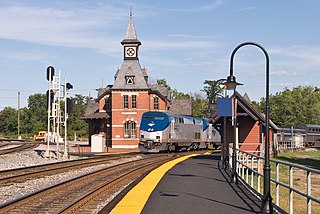
Point of Rocks is a historic passenger rail station on the MARC Brunswick Line between Washington, D.C., and Martinsburg, WV, located at Point of Rocks, Frederick County, Maryland, United States. The station was built by the Baltimore and Ohio Railroad in 1873, and designed by E. Francis Baldwin. It is situated at the junction of the B&O Old Main Line and the Metropolitan Branch. The Met Branch also opened in 1873 and became the principal route for passenger trains between Baltimore, Washington and points west.

Gambrill House, also known as Boscobel House and Edgewood, is a house near Frederick, Maryland in the Monocacy National Battlefield. It was listed on the National Register of Historic Places in 1985.
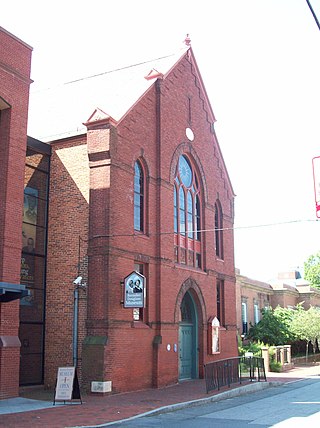
The Banneker-Douglass Museum, formerly known as Mt. Moriah African Methodist Episcopal Church, is a historic church at Annapolis, Anne Arundel County, Maryland. It was constructed in 1875 and remodeled in 1896. It is a 2+1⁄2-story, gable-front brick church executed in the Gothic Revival style. It served as the meeting hall for the First African Methodist Episcopal Church, originally formed in the 1790s, for nearly 100 years. It was leased to the Maryland Commission on African-American History and Culture, becoming the state's official museum for African-American history and culture. In 1984, a 2+1⁄2-story addition was added when the building opened as the Banneker-Douglass Museum.

Pennterra is a Georgian farmhouse near Thurmont, Maryland. The house is notable for its locally quarried stonework and its unusually fine proportions. The house was built at about the same time as nearby Strawberry Hill, which was built in 1783.
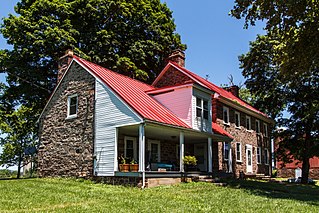
Strawberry Hill is a Georgian style farmhouse near Thurmont, Frederick County, Maryland, built in 1783. The house is substantially similar in plan to nearby Pennterra, but lacks Pennterra's later Victorian additions. The locally quarried stone includes an unusual diamond pattern on the southeast side of the house.
The Pearre-Metcalfe House is a historic home located at New Windsor, Frederick County, Maryland, United States. It is a brick Greek Revival style farmhouse, built about 1859. There is a small, brick springhouse with corbeled brick cornice and tin roof on the property.

The Amelung House and Glassworks is a historic home located at Urbana, Frederick County, Maryland, United States. It is a two-story, late-Georgian brick home on a stone foundation built about 1785. The property once had the New Bremen glassworks built by Johann Friedrich Amelung after he came to Maryland in 1784; no above-ground remains of the factory remain. Fine examples of New Bremen glass work may be seen at the Metropolitan Museum of Art in New York City; the Corning Museum of Glass in Corning, New York; and Winterthur Museum in Winterthur, Delaware.

Graceham Moravian Church and Parsonage is a historic church building and parsonage located at 8231 Rocky Ridge Road, MD 77 in Graceham, east of Thurmont, Frederick County, Maryland. It is a two-story Flemish bond brick church built in 1822, and covered with white stucco because of deteriorated masonry. The church was built as an addition to the adjacent meeting house and parsonage built in 1797. This building and the church's cemetery having uniform flat gravestones represents Maryland's only remaining 18th century Moravian settlement.
Shoemaker III Village Site is an archaeological site near Emmitsburg, in the extreme northern section of Frederick County, Maryland. Pottery fragments, projectile points, and other artifacts found at the site date it to 900–1300.

The Roddy Road Covered Bridge is a small, one lane king post wooden covered bridge near Thurmont, Frederick County, Maryland. It crosses Owen's Creek near Thurmont. It is 40 feet long, 16 feet wide, with a 12 foot-8 inch clearance. It was built between 1850 and 1860.
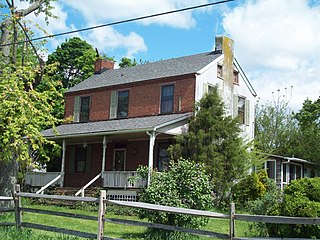
The Joshua Lowe House is a historic home located at Rising Sun, Cecil County, Maryland, United States. It is a two-story, center passage plan brick building three bays wide by two bays deep, built about 1830 in the late Federal. The house is one of the earliest and most substantial buildings in the crossroads village of Rock Springs and served as the first post office for the community from 1830 to 1838.
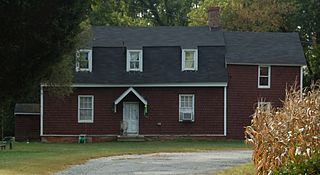
Poplar Hill is a historic home located at Aberdeen, Harford County, Maryland. It is a 1+1⁄2-story, gambrel-roofed frame house, built in the mid-18th century. A late-19th-century one-bay, two-story, gable-roofed wing is attached.

Creagerstown is an unincorporated community in Frederick County, Maryland, United States. It is playfully known by its residents as "4 miles from everywhere" because of its situation at 4 miles (6.4 km) from Thurmont, Woodsboro, Rocky Ridge, and Lewistown.

Knoxville is an unincorporated community in Frederick and Washington counties, Maryland, United States. The Robert Clagett Farm and Magnolia Plantation are listed on the National Register of Historic Places.

Ijamsville is an unincorporated community located 7 miles (11 km) southeast of Frederick, in Frederick County, Maryland, United States. The town was founded by Plummer Ijams, a descendant of Welsh immigrants, from whom the town took its name. The discovery of high-quality slate in the area led to Ijamsville's brief era as a mining town, which lasted until it transitioned to agriculture in the mid-1800s. In the mid-to-late 20th century, large quantities of land in Ijamsville were purchased by developers, and the town became primarily residential as a suburb of Frederick, Baltimore, and D.C.

The Landon House, also known as the Stancioff House, is a historic home located at Urbana, Frederick County, Maryland, United States. It was built about 1849 and is a large three-story frame house with a notable clerestory roof, and two-story full length galleried porch. The home's interior woodwork is of a simple Greek Revival style. The former smokehouse has been converted to a chapel. The house is said to have originally stood on the Rappahannock River near Fredericksburg, Virginia, and moved to its present location in 1846 at the direction of the Reverend R.H. Phillips. It has been used as both a school and private home. Reverend Phillips established a Female Seminary here between 1846 and 1850, then become a military institute for boys, and by the end of the 1850s it apparently had resumed its role as a Female Seminary. It was used by the 155th Pennsylvania Volunteers as a resting point for Union Troops marching toward the Battle of Antietam on September 16, 1862. The house would host a cotillion ball for Confederate soldiers before eventually becoming a field hospital during the civil war. During 2013 the building was purchased by new owners who have plans to restore it to its Civil War state.

Oakdale is a historic plantation located in Daisy, (Woodbine) Howard County, Maryland, former home of Maryland Governor Edwin Warfield.






















